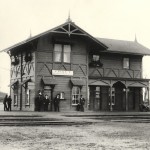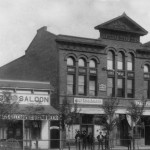Tracy’s history follows much of California’s. First inhabited by the Indigenous Peoples of the San Joaquin Valley, in the early 1800s much of the land around Tracy was part of Spanish and Mexican haciendas, then, later in the century, railroad land grants. As parcels were sold and remaining land homesteaded, farmers and ranchers, many of them European immigrants, set up stake in the area.
The Valley’s Indigenous Peoples
The Yokuts were the Indigenous peoples who lived in the San Joaquin Valley around Tracy. Their lives revolved around the wet and dry seasons, relying on food and water from the rivers, acorns from the valley oaks and other plants and seeds, and wild game. As with other native Californians, they were displaced by European settlers and fell victim to their diseases. The museum includes some artifacts from local Native American culture – such as a mortar and pestle used to grind acorns – and other donated collections.
European Migration Begins
In the late 1860s, the “Salana”, captained by John Collins, sailed railroad ties to Mohr’s Landing used to build the first tracks through the valley. Collins’ wife, Ana, sewed the 35 star flag – on display in the museum – that flew over the schooner. John was the father of Adolph Linne and grandfather of Wilma Linne Frydendahl, dry land farmers to the south of town near present day Linne Road.
The Railroad Expands
Tracy’s history is the history of the railroad in the north San Joaquin valley. The rail line through the present site of Tracy in 1869 came but a few months after the greatest locomotive news of the century, the joining of the Central and Union Pacific Railroads at Promontory Territory of Utah on May 10,1869, which established Transcontinental Rail Service across the U.S. The Central Pacific Railroad that ran from Sacramento was built through the present site of Tracy, over Altamont Pass, through Niles Canyon to Niles, and then by ferry to San Francisco.
Nearby Lathrop consisted of a roundhouse, a railroad shop, yards, and hotels for feeding railroad employees. The community became the railroad business center and the headquarters for the Central Pacific Railroad for the San Joaquin Valley. The increasing volume of business being handled by the railroad required a coaling station at the foot of the Altamont Hills just 14 miles west of Lathrop. A coaling station, named Ellis, was established west of present day downtown Tracy between Corral Hollow Road and Lammers Road along old Schulte Road.
Railroad shops for “helper engines” were built at Ellis. The helper engines were necessary to push the trains heading west over the nearby first grade of the Altamont Pass. Telegraph operators and all other necessary railroad employees and their families lived in Ellis by 1870 and the town included about 45 buildings.
The year 1870 also was the year in which the Southern Pacific Railroad Company and the Central Pacific came under common control. But it was not until 1885 when the Central Pacific executed a lease to the Southern Pacific Company were the two lines actually consolidated. The new company was called Southern Pacific.
In 1878 construction was started by the Southern Pacific Company on a new rail line from Oakland around the shores of San Francisco Bay, through Port Costa and Martinez, to connect with the Central Pacific line east of the Livermore hills and Altamont Pass. The connection between the two railroads was completed three miles east of Ellis on September 8, 1878. The result of this line connection was the founding of Tracy.
Railroad officials saw no reason for continuing the coaling station at Ellis and the “helper trains” were no longer needed. The railroad facilities were moved 3 miles east to the new railroad station called “Tracy”. The name Tracy was chosen for a Southern Pacific, Lathrop J. Tracy.
The residents of Ellis had realized that their town was doomed and decided that Tracy would soon become a leading railroad and commercial center of Tulare Township. Railroad families and businesses followed the railroad station, including two hotels, Ludwig Hotel and what became the Tracy Hotel. Jim Eagan, a railroader who worked at Ellis putting coal on engines was one of the first Tracy residents. He was placed in charge of the first Southern Pacific Railroad crew.
Tracy was growing as a railroad center. The new line through Los Banos was the fastest and least expensive route to Los Angeles. On March 1, 1894, the railroad headquarters at Lathrop was moved to Tracy. All the railroad equipment including engines and buildings, except the eating house, were involved in the transfer. Construction of a roundhouse started in Tracy in 1896. The museum displays many artifacts from Tracy’s railroad heydays.
Agriculture Grows
In the latter half of the 19th century, agriculture took hold, first with sheep grazing, moving flocks to the hills and down to the valley with the seasons, then with farming as the Delta levees were built and river irrigation established. Sheep ranches largely gave way to cattle around World War I. Farming, even on the drier west side of the valley, flourished with varied crops like barley, tomatoes, asparagus, nuts and fruit and large processing plants. By the 1950s, agriculture was Tracy’s main industry. The museum provides examples and period photographs of farm practices and life.
Throughout the late 1800s and early 1900s, Tracy remained relatively small and isolated, reaching only 11,000 as late as 1960s. Life in town was focused on commerce to support the railroads and surrounding farms and ranches and surrounding government services and projects. The railroads brought a rough transient style, including bordellos and gambling that lasted into the late 1950s. Farmers and merchants sowed more stability working to the cycles of the crops.
Town to City
Tracy remained a regional railroad town and local commerce center for surrounding farms and ranches into the 1970s, when growth in the bay area started to spill over the Altamont and turn the small town of Tracy into the city of today.



